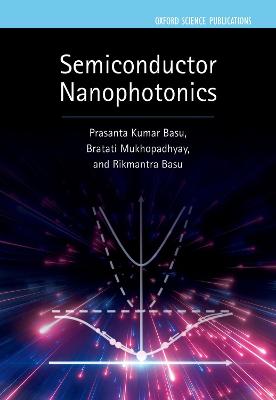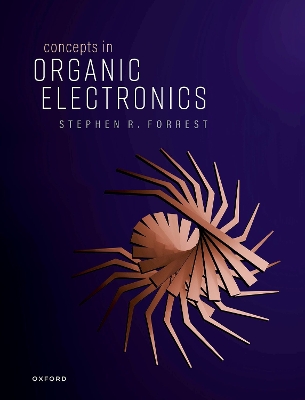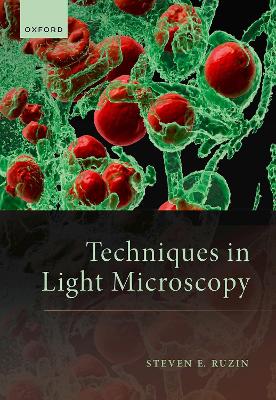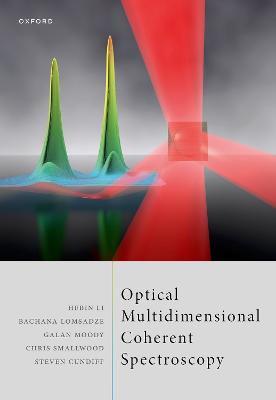Semiconductor Nanophotonics
 -10%
portes grátis
-10%
portes grátis
Semiconductor Nanophotonics
Basu, Rikmantra; Basu, Prasanta Kumar; Mukhopadhyay, Bratati
Oxford University Press
04/2022
592
Dura
Inglês
9780198784692
15 a 20 dias
1278
Descrição não disponível.
Preface
Acknowledgements
Chapter 1: Introduction
1.1: Introduction to Nanophotonics
1.2: Nanophotonics : Scope
1.3: Introduction to Nanostructures
1.4: Novel Phenomena in Nanophotonics: A Brief Outline
1.5: Applications of Nanophotonics
1.6: Problems of Integration
Chapter 2: Basic Properties of Semiconductors
2.1: Introduction
2.2: Band Structure
2.3: Density of States
2.4: Doping
2.5: Carrier Concentration
2.6: Carrier Concentration
2.7: Excess Carriers and Recombination
2.8: Excitons
2.9: Alloys and Heterojunctions
2.10: Quantum Structures
2.11: Strained Layers
Chapter 3: Macroscopic Theory of Optical Processes
3.1: Introduction
3.2: Optical Constants
3.3: Phase and Group Velocities
3.4: Susceptibility of a Material: a Classical Model
3.5: Einstein's Model for Light-Matter Interaction
Chapter 4: Photons and Electron-photon Interactions
4.1: Introduction
4.2: Wave Equation in a Rectangular Cavity
4.3: Quantization of the Radiation Field
4.4: Time Dependent Perturbation Theory
4.5: Interaction of an Electron with the Electromagnetic Field
4.6: Second Order Perturbation Theory
Chapter 5: Electron Photon Interactions in Bulk Semiconductors
5.1: Introduction
5.2: Absorption Processes in Semiconductors
5.3: Fundamental Absorption in Direct gap
5.4: Intervalence Band Absorption
5.5: Free Carrier Absorption
5.6: Recombination and Luminescence
5.7: NonradiativeRecombination
5.8: Carrier Effect on Absorption and Refractive Index
5.9: Gain in Semiconductors
Chapter 6: Optical Processes in QWs
6.1: Introduction
6.2: Optical Processes in QWs
6.3: Interband Absorption
6.4: Intersubband Absorption
6.5: Recombination in QWs
6.6: Loss Processes in QWs
6.7: Gain in QWs
6.8: Strained QW Lasers
Chapter 7: Excitons in Bulk Semiconductors and QWs
7.1: Introduction
7.2: Excitons in Bulk Semiconductors
7.3: Excitonic Processes in QWs
7.4: Line Broadening Mechanisms for 2D Excitons
7.5: Effect of Electric Field in Semiconductors
7.6: Excitonic Characteristics in Fractional Dimensional Space
Chapter 8: Nanowires
8.1: Introduction
8.2: Quantum Wires: Preliminaries
8.3: Excitonic Processes in QWRs
8.4: Classification of Nanowires
8.5: Growth of QWRs
8.6: Nanowires
8.7: Properties of NWRs
8.8: Applications of NWRs
Chapter 9: Nanoparticles
9.1: Introduction
9.2: Quantum Dots
9.3: QD Growth Mechanisms and Structures
9.4: Zero Dimensional Systems
9.5: Deviation from Simple Theory: Effect of Broadening
9.6: QD Lasers : Structure and Gain Calculation
9.7: Intersubband Transitions
9.8: Excitonic Processes in QDs
9.9: Classification of Nanocrystals
9.10: Synthesis of Nanocrystals
9.11: Core-Shell Structures
9.12: Bright and Dark Excitons
9.13: Biexcitons and Trions
9.14: Applications
Chapter 10: Microcavity
10.1: Introduction
10.2: Cavity Fundamentals
10.3: Fabry-Perot Resonators
10.4: Bragg Gratings and Bragg Mirrors
10.5: Ring Resonators
10.6: Whispering Gallery Mode Resonators
10.7: Wave Propagation in Periodic Structures: Photonic Crystals
10.8: Micropillar
10.9: Characteristics of Microcavity
Chapter 11: Cavity Quantum Elecrodynamics
11.1: Introduction
11.2: Zero-Point Energy and Vacuum Field
11.3: Control of Spontaneous Emission
11.4: Mode Density in Ideal Cavities
11.5: Experimental Observation of Purcell Effect
11.6: Strong Light-Matter Coupling
11.7: Jaynes-Cummins Model
11.8: Microcavities in CQED Experiments
11.9: Applications
11.10: Microcavity Laser
Chapter 12: Bose Einstein Condensation
12.1: Introduction
12.2: Elements of Bose Einstein Condensation
12.3: BEC in Semiconductors
12.4: Bulk Excitons
12.5: Indirect Excitons in Coupled QWs
12.6: Polariton
12.7: Polariton Lasers
12.8: Modeling of Electrically Driven Polariton Laser
Chapter 13: Surface Plasmons
13.1: Introduction
13.2: Basic Concepts
13.3: Surface Plasmon Polaritons at Metal/Insulator Interfaces
13.4: Excitation Mechanism
13.5: Materials
13.6: Length Scales in Noble Metals
13.7: Metal-insulator Based Plasmonics-photonics
13.8: All Semiconductor Plasmonics
13.9: Plasmonic Properties of Semiconductors
13.10: Components: source, modulators, waveguides, detector
13.11: Application of Plasmonics in VLSI, Data Centres and Supercomputers
13.12: Applications of Surface Plasmons in Basic Science and Characterization
13.13: Intersubband Plasmons
Chapter 14: Spasers and Plasmonic Nanolasers
14.1: Introduction
14.2: Early Investigations on SP Amplification
14.3: Models for Noginov et al Experiment
14.4: Semiconductor Spasers and Plasmonic Nanolasers
14.5: Theoretical Models by Khurgin and Sun
14.6: Current Theoretical Models and Experiments
14.7: Further Developments
Chapter 15: Optical Metamaterials
15.1: Introduction
15.2: Left Handed Material with Negative RI
15.3: Structures for Microwaves
15.4: Perfect Lens
15.5: NIR with Positive Permittivity and Permeability
15.6: Low Loss Plasmonic Metamaterial
15.7: Semiconductor Metamaterials
15.8: Metasurfaces
15.9: Beam Steering
Chapter 16: Nanolasers
16.1: Introduction
16.2: Parameters of Lasers
16.3: Progress in Nanolasers
16.4: Threshold Pump Power of Nanolasers: Purcell Effect
16.5: Intrinsic Merit of Nanolasers
16.6: Optical Interconnect
16.7: Metal Based Nanolasers
Acknowledgements
Chapter 1: Introduction
1.1: Introduction to Nanophotonics
1.2: Nanophotonics : Scope
1.3: Introduction to Nanostructures
1.4: Novel Phenomena in Nanophotonics: A Brief Outline
1.5: Applications of Nanophotonics
1.6: Problems of Integration
Chapter 2: Basic Properties of Semiconductors
2.1: Introduction
2.2: Band Structure
2.3: Density of States
2.4: Doping
2.5: Carrier Concentration
2.6: Carrier Concentration
2.7: Excess Carriers and Recombination
2.8: Excitons
2.9: Alloys and Heterojunctions
2.10: Quantum Structures
2.11: Strained Layers
Chapter 3: Macroscopic Theory of Optical Processes
3.1: Introduction
3.2: Optical Constants
3.3: Phase and Group Velocities
3.4: Susceptibility of a Material: a Classical Model
3.5: Einstein's Model for Light-Matter Interaction
Chapter 4: Photons and Electron-photon Interactions
4.1: Introduction
4.2: Wave Equation in a Rectangular Cavity
4.3: Quantization of the Radiation Field
4.4: Time Dependent Perturbation Theory
4.5: Interaction of an Electron with the Electromagnetic Field
4.6: Second Order Perturbation Theory
Chapter 5: Electron Photon Interactions in Bulk Semiconductors
5.1: Introduction
5.2: Absorption Processes in Semiconductors
5.3: Fundamental Absorption in Direct gap
5.4: Intervalence Band Absorption
5.5: Free Carrier Absorption
5.6: Recombination and Luminescence
5.7: NonradiativeRecombination
5.8: Carrier Effect on Absorption and Refractive Index
5.9: Gain in Semiconductors
Chapter 6: Optical Processes in QWs
6.1: Introduction
6.2: Optical Processes in QWs
6.3: Interband Absorption
6.4: Intersubband Absorption
6.5: Recombination in QWs
6.6: Loss Processes in QWs
6.7: Gain in QWs
6.8: Strained QW Lasers
Chapter 7: Excitons in Bulk Semiconductors and QWs
7.1: Introduction
7.2: Excitons in Bulk Semiconductors
7.3: Excitonic Processes in QWs
7.4: Line Broadening Mechanisms for 2D Excitons
7.5: Effect of Electric Field in Semiconductors
7.6: Excitonic Characteristics in Fractional Dimensional Space
Chapter 8: Nanowires
8.1: Introduction
8.2: Quantum Wires: Preliminaries
8.3: Excitonic Processes in QWRs
8.4: Classification of Nanowires
8.5: Growth of QWRs
8.6: Nanowires
8.7: Properties of NWRs
8.8: Applications of NWRs
Chapter 9: Nanoparticles
9.1: Introduction
9.2: Quantum Dots
9.3: QD Growth Mechanisms and Structures
9.4: Zero Dimensional Systems
9.5: Deviation from Simple Theory: Effect of Broadening
9.6: QD Lasers : Structure and Gain Calculation
9.7: Intersubband Transitions
9.8: Excitonic Processes in QDs
9.9: Classification of Nanocrystals
9.10: Synthesis of Nanocrystals
9.11: Core-Shell Structures
9.12: Bright and Dark Excitons
9.13: Biexcitons and Trions
9.14: Applications
Chapter 10: Microcavity
10.1: Introduction
10.2: Cavity Fundamentals
10.3: Fabry-Perot Resonators
10.4: Bragg Gratings and Bragg Mirrors
10.5: Ring Resonators
10.6: Whispering Gallery Mode Resonators
10.7: Wave Propagation in Periodic Structures: Photonic Crystals
10.8: Micropillar
10.9: Characteristics of Microcavity
Chapter 11: Cavity Quantum Elecrodynamics
11.1: Introduction
11.2: Zero-Point Energy and Vacuum Field
11.3: Control of Spontaneous Emission
11.4: Mode Density in Ideal Cavities
11.5: Experimental Observation of Purcell Effect
11.6: Strong Light-Matter Coupling
11.7: Jaynes-Cummins Model
11.8: Microcavities in CQED Experiments
11.9: Applications
11.10: Microcavity Laser
Chapter 12: Bose Einstein Condensation
12.1: Introduction
12.2: Elements of Bose Einstein Condensation
12.3: BEC in Semiconductors
12.4: Bulk Excitons
12.5: Indirect Excitons in Coupled QWs
12.6: Polariton
12.7: Polariton Lasers
12.8: Modeling of Electrically Driven Polariton Laser
Chapter 13: Surface Plasmons
13.1: Introduction
13.2: Basic Concepts
13.3: Surface Plasmon Polaritons at Metal/Insulator Interfaces
13.4: Excitation Mechanism
13.5: Materials
13.6: Length Scales in Noble Metals
13.7: Metal-insulator Based Plasmonics-photonics
13.8: All Semiconductor Plasmonics
13.9: Plasmonic Properties of Semiconductors
13.10: Components: source, modulators, waveguides, detector
13.11: Application of Plasmonics in VLSI, Data Centres and Supercomputers
13.12: Applications of Surface Plasmons in Basic Science and Characterization
13.13: Intersubband Plasmons
Chapter 14: Spasers and Plasmonic Nanolasers
14.1: Introduction
14.2: Early Investigations on SP Amplification
14.3: Models for Noginov et al Experiment
14.4: Semiconductor Spasers and Plasmonic Nanolasers
14.5: Theoretical Models by Khurgin and Sun
14.6: Current Theoretical Models and Experiments
14.7: Further Developments
Chapter 15: Optical Metamaterials
15.1: Introduction
15.2: Left Handed Material with Negative RI
15.3: Structures for Microwaves
15.4: Perfect Lens
15.5: NIR with Positive Permittivity and Permeability
15.6: Low Loss Plasmonic Metamaterial
15.7: Semiconductor Metamaterials
15.8: Metasurfaces
15.9: Beam Steering
Chapter 16: Nanolasers
16.1: Introduction
16.2: Parameters of Lasers
16.3: Progress in Nanolasers
16.4: Threshold Pump Power of Nanolasers: Purcell Effect
16.5: Intrinsic Merit of Nanolasers
16.6: Optical Interconnect
16.7: Metal Based Nanolasers
Este título pertence ao(s) assunto(s) indicados(s). Para ver outros títulos clique no assunto desejado.
Preface
Acknowledgements
Chapter 1: Introduction
1.1: Introduction to Nanophotonics
1.2: Nanophotonics : Scope
1.3: Introduction to Nanostructures
1.4: Novel Phenomena in Nanophotonics: A Brief Outline
1.5: Applications of Nanophotonics
1.6: Problems of Integration
Chapter 2: Basic Properties of Semiconductors
2.1: Introduction
2.2: Band Structure
2.3: Density of States
2.4: Doping
2.5: Carrier Concentration
2.6: Carrier Concentration
2.7: Excess Carriers and Recombination
2.8: Excitons
2.9: Alloys and Heterojunctions
2.10: Quantum Structures
2.11: Strained Layers
Chapter 3: Macroscopic Theory of Optical Processes
3.1: Introduction
3.2: Optical Constants
3.3: Phase and Group Velocities
3.4: Susceptibility of a Material: a Classical Model
3.5: Einstein's Model for Light-Matter Interaction
Chapter 4: Photons and Electron-photon Interactions
4.1: Introduction
4.2: Wave Equation in a Rectangular Cavity
4.3: Quantization of the Radiation Field
4.4: Time Dependent Perturbation Theory
4.5: Interaction of an Electron with the Electromagnetic Field
4.6: Second Order Perturbation Theory
Chapter 5: Electron Photon Interactions in Bulk Semiconductors
5.1: Introduction
5.2: Absorption Processes in Semiconductors
5.3: Fundamental Absorption in Direct gap
5.4: Intervalence Band Absorption
5.5: Free Carrier Absorption
5.6: Recombination and Luminescence
5.7: NonradiativeRecombination
5.8: Carrier Effect on Absorption and Refractive Index
5.9: Gain in Semiconductors
Chapter 6: Optical Processes in QWs
6.1: Introduction
6.2: Optical Processes in QWs
6.3: Interband Absorption
6.4: Intersubband Absorption
6.5: Recombination in QWs
6.6: Loss Processes in QWs
6.7: Gain in QWs
6.8: Strained QW Lasers
Chapter 7: Excitons in Bulk Semiconductors and QWs
7.1: Introduction
7.2: Excitons in Bulk Semiconductors
7.3: Excitonic Processes in QWs
7.4: Line Broadening Mechanisms for 2D Excitons
7.5: Effect of Electric Field in Semiconductors
7.6: Excitonic Characteristics in Fractional Dimensional Space
Chapter 8: Nanowires
8.1: Introduction
8.2: Quantum Wires: Preliminaries
8.3: Excitonic Processes in QWRs
8.4: Classification of Nanowires
8.5: Growth of QWRs
8.6: Nanowires
8.7: Properties of NWRs
8.8: Applications of NWRs
Chapter 9: Nanoparticles
9.1: Introduction
9.2: Quantum Dots
9.3: QD Growth Mechanisms and Structures
9.4: Zero Dimensional Systems
9.5: Deviation from Simple Theory: Effect of Broadening
9.6: QD Lasers : Structure and Gain Calculation
9.7: Intersubband Transitions
9.8: Excitonic Processes in QDs
9.9: Classification of Nanocrystals
9.10: Synthesis of Nanocrystals
9.11: Core-Shell Structures
9.12: Bright and Dark Excitons
9.13: Biexcitons and Trions
9.14: Applications
Chapter 10: Microcavity
10.1: Introduction
10.2: Cavity Fundamentals
10.3: Fabry-Perot Resonators
10.4: Bragg Gratings and Bragg Mirrors
10.5: Ring Resonators
10.6: Whispering Gallery Mode Resonators
10.7: Wave Propagation in Periodic Structures: Photonic Crystals
10.8: Micropillar
10.9: Characteristics of Microcavity
Chapter 11: Cavity Quantum Elecrodynamics
11.1: Introduction
11.2: Zero-Point Energy and Vacuum Field
11.3: Control of Spontaneous Emission
11.4: Mode Density in Ideal Cavities
11.5: Experimental Observation of Purcell Effect
11.6: Strong Light-Matter Coupling
11.7: Jaynes-Cummins Model
11.8: Microcavities in CQED Experiments
11.9: Applications
11.10: Microcavity Laser
Chapter 12: Bose Einstein Condensation
12.1: Introduction
12.2: Elements of Bose Einstein Condensation
12.3: BEC in Semiconductors
12.4: Bulk Excitons
12.5: Indirect Excitons in Coupled QWs
12.6: Polariton
12.7: Polariton Lasers
12.8: Modeling of Electrically Driven Polariton Laser
Chapter 13: Surface Plasmons
13.1: Introduction
13.2: Basic Concepts
13.3: Surface Plasmon Polaritons at Metal/Insulator Interfaces
13.4: Excitation Mechanism
13.5: Materials
13.6: Length Scales in Noble Metals
13.7: Metal-insulator Based Plasmonics-photonics
13.8: All Semiconductor Plasmonics
13.9: Plasmonic Properties of Semiconductors
13.10: Components: source, modulators, waveguides, detector
13.11: Application of Plasmonics in VLSI, Data Centres and Supercomputers
13.12: Applications of Surface Plasmons in Basic Science and Characterization
13.13: Intersubband Plasmons
Chapter 14: Spasers and Plasmonic Nanolasers
14.1: Introduction
14.2: Early Investigations on SP Amplification
14.3: Models for Noginov et al Experiment
14.4: Semiconductor Spasers and Plasmonic Nanolasers
14.5: Theoretical Models by Khurgin and Sun
14.6: Current Theoretical Models and Experiments
14.7: Further Developments
Chapter 15: Optical Metamaterials
15.1: Introduction
15.2: Left Handed Material with Negative RI
15.3: Structures for Microwaves
15.4: Perfect Lens
15.5: NIR with Positive Permittivity and Permeability
15.6: Low Loss Plasmonic Metamaterial
15.7: Semiconductor Metamaterials
15.8: Metasurfaces
15.9: Beam Steering
Chapter 16: Nanolasers
16.1: Introduction
16.2: Parameters of Lasers
16.3: Progress in Nanolasers
16.4: Threshold Pump Power of Nanolasers: Purcell Effect
16.5: Intrinsic Merit of Nanolasers
16.6: Optical Interconnect
16.7: Metal Based Nanolasers
Acknowledgements
Chapter 1: Introduction
1.1: Introduction to Nanophotonics
1.2: Nanophotonics : Scope
1.3: Introduction to Nanostructures
1.4: Novel Phenomena in Nanophotonics: A Brief Outline
1.5: Applications of Nanophotonics
1.6: Problems of Integration
Chapter 2: Basic Properties of Semiconductors
2.1: Introduction
2.2: Band Structure
2.3: Density of States
2.4: Doping
2.5: Carrier Concentration
2.6: Carrier Concentration
2.7: Excess Carriers and Recombination
2.8: Excitons
2.9: Alloys and Heterojunctions
2.10: Quantum Structures
2.11: Strained Layers
Chapter 3: Macroscopic Theory of Optical Processes
3.1: Introduction
3.2: Optical Constants
3.3: Phase and Group Velocities
3.4: Susceptibility of a Material: a Classical Model
3.5: Einstein's Model for Light-Matter Interaction
Chapter 4: Photons and Electron-photon Interactions
4.1: Introduction
4.2: Wave Equation in a Rectangular Cavity
4.3: Quantization of the Radiation Field
4.4: Time Dependent Perturbation Theory
4.5: Interaction of an Electron with the Electromagnetic Field
4.6: Second Order Perturbation Theory
Chapter 5: Electron Photon Interactions in Bulk Semiconductors
5.1: Introduction
5.2: Absorption Processes in Semiconductors
5.3: Fundamental Absorption in Direct gap
5.4: Intervalence Band Absorption
5.5: Free Carrier Absorption
5.6: Recombination and Luminescence
5.7: NonradiativeRecombination
5.8: Carrier Effect on Absorption and Refractive Index
5.9: Gain in Semiconductors
Chapter 6: Optical Processes in QWs
6.1: Introduction
6.2: Optical Processes in QWs
6.3: Interband Absorption
6.4: Intersubband Absorption
6.5: Recombination in QWs
6.6: Loss Processes in QWs
6.7: Gain in QWs
6.8: Strained QW Lasers
Chapter 7: Excitons in Bulk Semiconductors and QWs
7.1: Introduction
7.2: Excitons in Bulk Semiconductors
7.3: Excitonic Processes in QWs
7.4: Line Broadening Mechanisms for 2D Excitons
7.5: Effect of Electric Field in Semiconductors
7.6: Excitonic Characteristics in Fractional Dimensional Space
Chapter 8: Nanowires
8.1: Introduction
8.2: Quantum Wires: Preliminaries
8.3: Excitonic Processes in QWRs
8.4: Classification of Nanowires
8.5: Growth of QWRs
8.6: Nanowires
8.7: Properties of NWRs
8.8: Applications of NWRs
Chapter 9: Nanoparticles
9.1: Introduction
9.2: Quantum Dots
9.3: QD Growth Mechanisms and Structures
9.4: Zero Dimensional Systems
9.5: Deviation from Simple Theory: Effect of Broadening
9.6: QD Lasers : Structure and Gain Calculation
9.7: Intersubband Transitions
9.8: Excitonic Processes in QDs
9.9: Classification of Nanocrystals
9.10: Synthesis of Nanocrystals
9.11: Core-Shell Structures
9.12: Bright and Dark Excitons
9.13: Biexcitons and Trions
9.14: Applications
Chapter 10: Microcavity
10.1: Introduction
10.2: Cavity Fundamentals
10.3: Fabry-Perot Resonators
10.4: Bragg Gratings and Bragg Mirrors
10.5: Ring Resonators
10.6: Whispering Gallery Mode Resonators
10.7: Wave Propagation in Periodic Structures: Photonic Crystals
10.8: Micropillar
10.9: Characteristics of Microcavity
Chapter 11: Cavity Quantum Elecrodynamics
11.1: Introduction
11.2: Zero-Point Energy and Vacuum Field
11.3: Control of Spontaneous Emission
11.4: Mode Density in Ideal Cavities
11.5: Experimental Observation of Purcell Effect
11.6: Strong Light-Matter Coupling
11.7: Jaynes-Cummins Model
11.8: Microcavities in CQED Experiments
11.9: Applications
11.10: Microcavity Laser
Chapter 12: Bose Einstein Condensation
12.1: Introduction
12.2: Elements of Bose Einstein Condensation
12.3: BEC in Semiconductors
12.4: Bulk Excitons
12.5: Indirect Excitons in Coupled QWs
12.6: Polariton
12.7: Polariton Lasers
12.8: Modeling of Electrically Driven Polariton Laser
Chapter 13: Surface Plasmons
13.1: Introduction
13.2: Basic Concepts
13.3: Surface Plasmon Polaritons at Metal/Insulator Interfaces
13.4: Excitation Mechanism
13.5: Materials
13.6: Length Scales in Noble Metals
13.7: Metal-insulator Based Plasmonics-photonics
13.8: All Semiconductor Plasmonics
13.9: Plasmonic Properties of Semiconductors
13.10: Components: source, modulators, waveguides, detector
13.11: Application of Plasmonics in VLSI, Data Centres and Supercomputers
13.12: Applications of Surface Plasmons in Basic Science and Characterization
13.13: Intersubband Plasmons
Chapter 14: Spasers and Plasmonic Nanolasers
14.1: Introduction
14.2: Early Investigations on SP Amplification
14.3: Models for Noginov et al Experiment
14.4: Semiconductor Spasers and Plasmonic Nanolasers
14.5: Theoretical Models by Khurgin and Sun
14.6: Current Theoretical Models and Experiments
14.7: Further Developments
Chapter 15: Optical Metamaterials
15.1: Introduction
15.2: Left Handed Material with Negative RI
15.3: Structures for Microwaves
15.4: Perfect Lens
15.5: NIR with Positive Permittivity and Permeability
15.6: Low Loss Plasmonic Metamaterial
15.7: Semiconductor Metamaterials
15.8: Metasurfaces
15.9: Beam Steering
Chapter 16: Nanolasers
16.1: Introduction
16.2: Parameters of Lasers
16.3: Progress in Nanolasers
16.4: Threshold Pump Power of Nanolasers: Purcell Effect
16.5: Intrinsic Merit of Nanolasers
16.6: Optical Interconnect
16.7: Metal Based Nanolasers
Este título pertence ao(s) assunto(s) indicados(s). Para ver outros títulos clique no assunto desejado.







